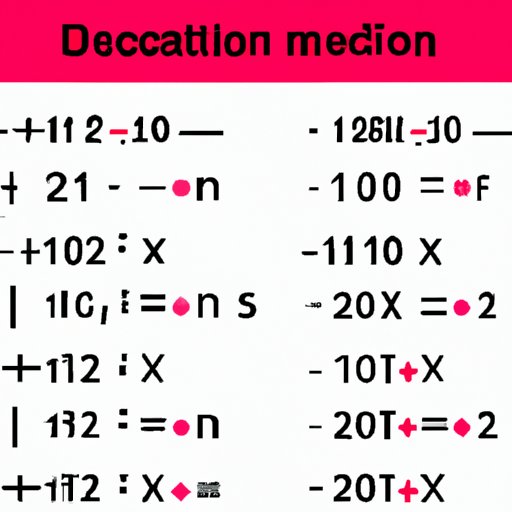Introduction
Decimals and fractions are two fundamental concepts in mathematics. A decimal is a number that includes a decimal point, whereas a fraction is a ratio of two integers. Knowing how to convert decimals to fractions is essential for mathematical proficiency, as well as other real-life applications. In this article, we will provide a comprehensive guide on how to convert decimals to fractions effectively using the “multiply and simplify” method.
Converting Common Decimal Fractions to Fractions
Converting common decimal fractions such as 0.5, 0.25, 0.125, 0.4, and 0.375 to fractions is relatively easy. The following steps will guide you through the conversion process:
1. Write down the decimal as a fraction, placing the decimal number over 1 followed by zeros based on the number of decimal places. For instance, 0.25 becomes 25/100, and 0.375 becomes 375/1000.
2. Simplify the fraction by dividing both the numerator and denominator by their greatest common factor. For example, 25/100 simplifies to 1/4, and 375/1000 simplifies to 3/8.
Here are some practice problems for you to solve:
Convert 0.75 to a fraction.
Convert 0.2 to a fraction.
Convert 0.125 to a fraction.
Converting Repeating Decimals to Fractions
Repeating decimals, also known as recurring decimals, consist of a decimal part that repeats indefinitely. The following are steps to convert repeating decimals to fractions:
1. Recognize the repeating digit, e.g., 0.333, where the digit 3 repeats.
2. Write down the fraction, with the repeating digit as the numerator and the denominator consisting of as many nines as the total number of digits repeating. For example, 0.333 forms a fraction with a numerator of 3 and a denominator of 9.
3. Simplify the fraction by dividing both the numerator and denominator by their greatest common factor.
Here are some practice problems for you to solve:
Convert 0.666 to a fraction.
Convert 0.8(repeat) to a fraction.
Convert 0.2121(repeat) to a fraction.
Overcoming Common Challenges when Converting Decimals to Fractions
While converting decimals to fractions, you may encounter challenges such as terminating decimals, round-off errors, and improper fractions. Here are some tips to help you overcome these challenges:
1. Terminating decimals convert to fractions with denominators that are powers of ten.
2. Round-off errors can lead to inaccuracies. Always convert decimals to fractions first before performing calculations.
3. Improper fractions need to be simplified before converting back to mixed numbers.
Comparing and Contrasting Different Methods of Converting Decimals to Fractions
Several methods can be used to convert decimals to fractions, such as the “multiply and simplify” method, long division method, and continued fraction method. Here is a comparison of each method’s pros and cons:
1. “Multiply and simplify” method is straightforward but may not work for large repeating decimals.
2. Long division method is useful for complex decimals but can be time-consuming.
3. Continued fraction method provides accuracy but requires mastery of some algebra concepts.
When choosing the best method for converting decimals to fractions, consider its accuracy, ease of use, and speed.
Quick and Easy Tips for Converting Decimals to Fractions
If you need a fast and easy way to convert decimals to fractions, here are some cheat sheet-style tips:
1. To convert a decimal less than 1, move the decimal point to the right until it reaches the end.
2. To convert a decimal greater than 1, move the decimal point to the left until it reaches the beginning.
3. To convert repeating decimals without a scientific calculator, write the fraction as a ratio of two equations, solve for x, and simplify the fraction.
Using Real-life Scenarios to Demonstrate the Importance of Converting Decimals to Fractions
The ability to convert decimals to fractions is essential for understanding real-life situations such as recipes, time conversion, and distance and speed calculations. For instance, when following a recipe, converting a decimal to a fraction could help you determine the right amount of an ingredient required. Similarly, in distance and speed calculations, converting decimals to fractions can assist in understanding the distance covered or the time taken.
Conclusion
Converting decimals to fractions is a necessary skill in both mathematics and real-life applications. The “multiply and simplify” method is an effective way to convert common and repeating decimals to fractions. Overcoming common challenges like round-off errors and improper fractions requires practice. When choosing a method, consider accuracy, ease of use, and speed. Practicing the cheat sheet-style conversion tips will ensure quick and easy conversions. Finally, understanding real-life scenarios such as recipe measurements and distance calculations can help illustrate the importance of converting decimals to fractions.
